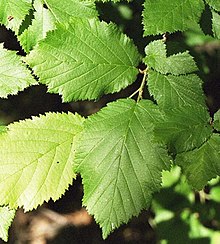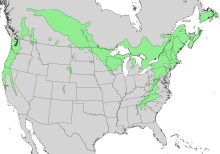Corylus cornuta
| Corylus cornuta | |
|---|---|

| |
| Beaked hazel foliage | |
| Scientific classification | |
| Kingdom: | Plantae |
| Clade: | Tracheophytes |
| Clade: | Angiosperms |
| Clade: | Eudicots |
| Clade: | Rosids |
| Order: | Fagales |
| Family: | Betulaceae |
| Genus: | Corylus |
| Species: | C. cornuta
|
| Binomial name | |
| Corylus cornuta | |

| |
| Natural range of Corylus cornuta | |
| Nutritional value per 100 g (3.5 oz) | |
|---|---|
| Energy | 2,629 kJ (628 kcal) |
22.98 g | |
| Dietary fiber | 9.8 g |
52.99 g | |
14.89 g | |
| Vitamins | Quantity %DV† |
| Thiamine (B1) | 40% 0.480 mg |
| Riboflavin (B2) | 12% 0.160 mg |
| Niacin (B3) | 20% 3.190 mg |
| Vitamin B6 | 32% 0.550 mg |
| Minerals | Quantity %DV† |
| Calcium | 34% 441 mg |
| Copper | 133% 1.200 mg |
| Iron | 17% 3.12 mg |
| Magnesium | 56% 235 mg |
| Manganese | 330% 7.600 mg |
| Phosphorus | 33% 411 mg |
| Potassium | 25% 738 mg |
| Sodium | 0% 2 mg |
| Zinc | 19% 2.06 mg |
| Other constituents | Quantity |
| Water | 5.92 g |
| †Percentages estimated using US recommendations for adults,[1] except for potassium, which is estimated based on expert recommendation from the National Academies.[2] | |
Corylus cornuta, the beaked hazelnut (or just beaked hazel), is a deciduous shrubby hazel found throughout most of North America, from southern Canada south to Georgia and California. It grows in dry woodlands and at forest edges and can reach 4–8 metres (13–26 ft) tall with stems 10–25 cm (4–9+3⁄4 in) thick with smooth gray bark,[3] but it can also remain relatively small in the shade of other plants. The leaves are green, rounded oval with a pointed tip, coarsely double-toothed, 5–11 cm (2–4+1⁄4 in) long and 3–8 cm (1+1⁄4–3+1⁄4 in) broad, with hairy undersides. The male flowers are catkins that form in the fall and pollinate single female flowers the following spring to allow the fruits to mature through the summer season.
Description
Corylus cornuta is named from its fruit, which is a nut enclosed in a husk with a tubular extension 2–4 cm (3⁄4–1+1⁄2 in) long that resembles a beak. Tiny filaments protrude from the husk and may stick into, and irritate, skin that contacts them. The spherical nuts, which are surrounded by a hard shell, are edible though small. The beaked hazel is the hardiest of all hazel species, surviving temperatures of −50 °C (−58 °F) at its northern limits.[3]
Varieties
There are two varieties, divided by geography:[4]
- Corylus cornuta var. cornuta – Eastern beaked hazel. Small shrub, 4 to 6 m (13 to 20 ft) tall;[4] 'beak' longer, 3 cm (1+1⁄4 in) or more.
- Corylus cornuta var. californica – Western beaked hazel or California hazelnut. Large shrub, 4 to 15 m (13 to 49 ft) tall;[4] 'beak' shorter, usually less than 3 cm (1+1⁄4 in). The Concow tribe called this variety gōm’-he’’-ni (Konkow language).[5]
Range and uses
The seeds are dispersed by jays and rodents such as red squirrels and least chipmunks.[4] Although C. cornuta is somewhat shade tolerant, it is more common in forests with fairly open canopies than denser ones.[4] However, it is intolerant of entirely open areas that get hot and dry.[3] Fire kills the above-ground portion of the shrub, but it resprouts fairly readily after fire, and in fact American Indians in California and Oregon used fire to encourage hazelnut growth, as they used hazelnuts for food, baskets, medicine, and other purposes.[4]
Squirrels eat the nuts of C. cornuta californica, and deer and livestock browse its foliage.[6]
Gallery
-
Male catkins
-
Female flowers
-
Leaves (and three fruits forming)
-
Immature fruit showing the "beak"
-
An immature nut with its hard shell
References
- ^ United States Food and Drug Administration (2024). "Daily Value on the Nutrition and Supplement Facts Labels". FDA. Archived from the original on 2024-03-27. Retrieved 2024-03-28.
- ^ National Academies of Sciences, Engineering, and Medicine; Health and Medicine Division; Food and Nutrition Board; Committee to Review the Dietary Reference Intakes for Sodium and Potassium (2019). Oria, Maria; Harrison, Meghan; Stallings, Virginia A. (eds.). Dietary Reference Intakes for Sodium and Potassium. The National Academies Collection: Reports funded by National Institutes of Health. Washington, DC: National Academies Press (US). ISBN 978-0-309-48834-1. PMID 30844154. Archived from the original on 2024-05-09. Retrieved 2024-06-21.
- ^ a b c "Corylus cornuta" (PDF). Alberta Centre for Reclamation and Restoration Ecology. University of Alberta. Archived from the original (PDF) on 23 August 2016. Retrieved 22 November 2017.
- ^ a b c d e f Fryer, Janet L. (2007). "Corylus cornuta". Fire Effects Information System (FEIS). US Department of Agriculture (USDA), Forest Service (USFS), Rocky Mountain Research Station, Fire Sciences Laboratory.
- ^ Chesnut, Victor King (1902). Plants used by the Indians of Mendocino County, California. Government Printing Office. p. 405. Retrieved 24 August 2012.
- ^ Whitney, Stephen (1985). Western Forests (The Audubon Society Nature Guides). New York: Knopf. p. 428. ISBN 0-394-73127-1.
External links
 Media related to Corylus cornuta at Wikimedia Commons
Media related to Corylus cornuta at Wikimedia Commons- Calflora
- Sawyer Jr., John O. (2012). "Corylus cornuta subsp. californica". In Jepson Flora Project (ed.). Jepson eFlora. The Jepson Herbarium, University of California, Berkeley.
- Corylus cornuta in the CalPhotos photo database, University of California, Berkeley





